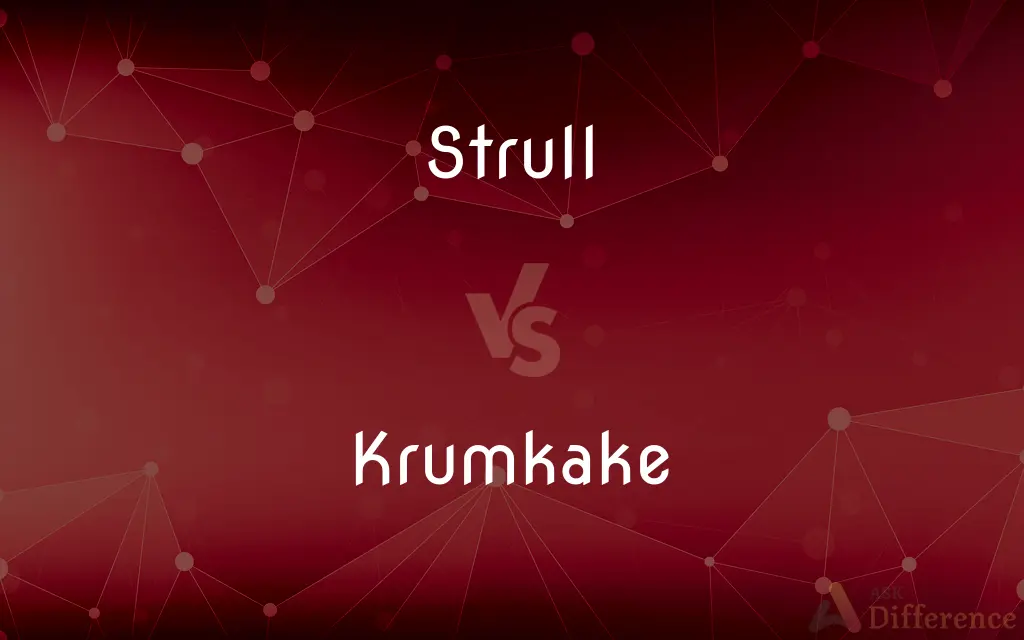Strull vs. Krumkake — What's the Difference?
By Tayyaba Rehman & Fiza Rafique — Updated on April 26, 2024
Strull is a Norwegian fried pastry, often doughnut-shaped, whereas Krumkake is a Norwegian waffle cookie, typically rolled into a cone shape.

Difference Between Strull and Krumkake
Table of Contents
ADVERTISEMENT
Key Differences
Strull is a traditional Norwegian pastry that is deep-fried, resulting in a crispy texture. In contrast, Krumkake is baked using a special iron, similar to a waffle iron, which imprints a delicate pattern onto the thin batter. This creates a soft texture that hardens into a crisp finish as it cools.
Strull is usually made from a dough that includes butter, flour, eggs, and milk, which is then shaped into rings or intricate designs before frying. Meanwhile, Krumkake batter is more liquid, consisting of eggs, sugar, flour, butter, and often cardamom, poured into the iron to form thin, round cookies.
The preparation of Strull involves deep-frying until golden brown, which gives it a distinctly rich and buttery flavor. On the other hand, Krumkake is cooked on a stovetop or electric iron, giving it a light, toasted flavor with subtle notes of spices like cardamom.
Strull is typically served plain or dusted with powdered sugar, emphasizing its fried, doughy character. Conversely, Krumkake is often filled with whipped cream, berries, or other sweet fillings, highlighting its role as a delicate dessert vessel.
In terms of serving occasions, Strull is often found at traditional Norwegian celebrations and is enjoyed as a festive treat. Whereas Krumkake is commonly prepared during Christmas time and serves as both a dessert and a decorative element on Norwegian holiday tables.
ADVERTISEMENT
Comparison Chart
Type
Fried pastry
Waffle cookie
Texture
Crispy and doughy
Thin and crisp
Ingredients
Butter, flour, eggs, milk
Eggs, sugar, flour, butter, cardamom
Cooking Method
Deep-fried
Baked in a special iron
Occasions
Celebrations, festivities
Christmas, special occasions
Compare with Definitions
Strull
A doughnut-shaped or intricately designed dessert popular in Norway.
The Strull on display were decorated beautifully.
Krumkake
Typically made with a thin batter that includes cardamom.
The Krumkake had a delightful hint of cardamom.
Strull
A Norwegian fried pastry typically made from dough that includes eggs and butter.
We enjoyed fresh Strull at the Norwegian festival.
Krumkake
A traditional Norwegian waffle cookie, cooked in a special iron that imprints a pattern.
Grandma’s Krumkake iron has been passed down through generations.
Strull
Often served during celebrations and festive times.
For our family reunion, we made Strull as a special treat.
Krumkake
Rolled into a cone shape while still warm and flexible.
After baking, the Krumkake must be quickly rolled into cones.
Strull
A crispy and richly flavored treat made by deep frying.
Strull’s crispy texture comes from being perfectly fried.
Krumkake
A staple during Norwegian Christmas celebrations.
Making Krumkake is one of our cherished Christmas traditions.
Strull
Typically dusted with powdered sugar before serving.
The Strull looked even more tempting with a dusting of powdered sugar.
Krumkake
Often filled with whipped cream or other sweet fillings.
We filled our Krumkake with homemade raspberry cream.
Strull
A bar placed so as to resist weight.
Krumkake
Krumkake (Norwegian: [ˈkrʊ̀mˌkɑːkə], meaning "curved cake"; plural krumkaker) is a Norwegian waffle cookie made of flour, butter, eggs, sugar, and cream. Descendent from the Italian pizzelle, a special decorative two-sided iron griddle, or the Sicilian cannolo, or similar to a waffle iron, is traditionally used to bake the thin round cakes.
Strull
A bar so placed as to resist weight.
Krumkake
A large thin cookie made from batter poured into an embossed mold with hinged plates.
Krumkake
A Norwegian cookie invented by emigrants to America, prepared as a rolled-up cone, sometimes with a filling.
Common Curiosities
What spice is commonly used in Krumkake batter?
Cardamom is commonly used in Krumkake batter to add flavor.
How is Krumkake made?
Krumkake is made by cooking a thin batter in a special patterned iron and then rolling it into a cone shape.
How are Strull and Krumkake similar?
Both Strull and Krumkake are traditional Norwegian desserts enjoyed during celebrations.
How does the texture of Strull differ from Krumkake?
Strull has a crispy and doughy texture due to deep frying, whereas Krumkake is thin and crisp.
What are typical ingredients in Strull?
Typical ingredients in Strull include butter, flour, eggs, and milk.
What is Strull?
Strull is a deep-fried Norwegian pastry, often made in a doughnut shape.
What is a common way to serve Strull?
Strull is commonly served plain or dusted with powdered sugar.
What fillings can be used in Krumkake?
Krumkake can be filled with whipped cream, berries, or other sweet fillings.
Is there a special tool required to make Krumkake?
Yes, a special Krumkake iron, similar to a waffle iron but with decorative patterns, is used.
What is the traditional time to make Krumkake in Norway?
Krumkake is traditionally made during the Christmas season.
Are Strull and Krumkake served at the same occasions?
Strull is often served at general celebrations, while Krumkake is particularly popular during Christmas.
How does the flavor of Strull differ from Krumkake?
Strull has a rich, buttery flavor from deep frying, while Krumkake has a light, toasted flavor with a hint of spices.
How long does it take to prepare Strull compared to Krumkake?
Preparing Strull generally takes less time than Krumkake, as Krumkake requires precise timing to bake and roll the cookies.
Can Strull have different shapes?
Yes, Strull can be shaped into rings or more intricate designs before frying.
What is the ideal texture for Krumkake after cooking?
Krumkake should be soft initially and then harden to a crisp texture as it cools.
Share Your Discovery

Previous Comparison
Bookkeeping vs. Accounting
Next Comparison
Stipend vs. SalaryAuthor Spotlight
Written by
Tayyaba RehmanTayyaba Rehman is a distinguished writer, currently serving as a primary contributor to askdifference.com. As a researcher in semantics and etymology, Tayyaba's passion for the complexity of languages and their distinctions has found a perfect home on the platform. Tayyaba delves into the intricacies of language, distinguishing between commonly confused words and phrases, thereby providing clarity for readers worldwide.
Co-written by
Fiza RafiqueFiza Rafique is a skilled content writer at AskDifference.com, where she meticulously refines and enhances written pieces. Drawing from her vast editorial expertise, Fiza ensures clarity, accuracy, and precision in every article. Passionate about language, she continually seeks to elevate the quality of content for readers worldwide.














































